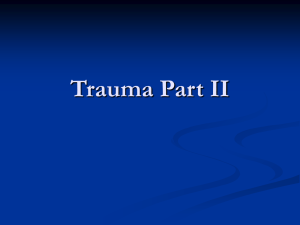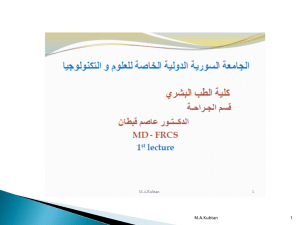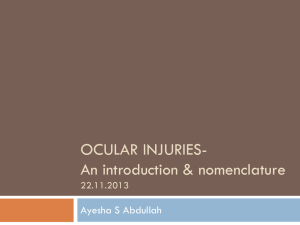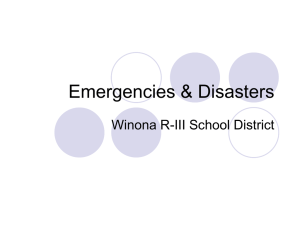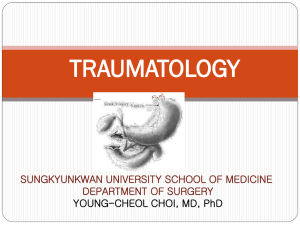Blast Injuries - HVA Center for EMS Education
advertisement
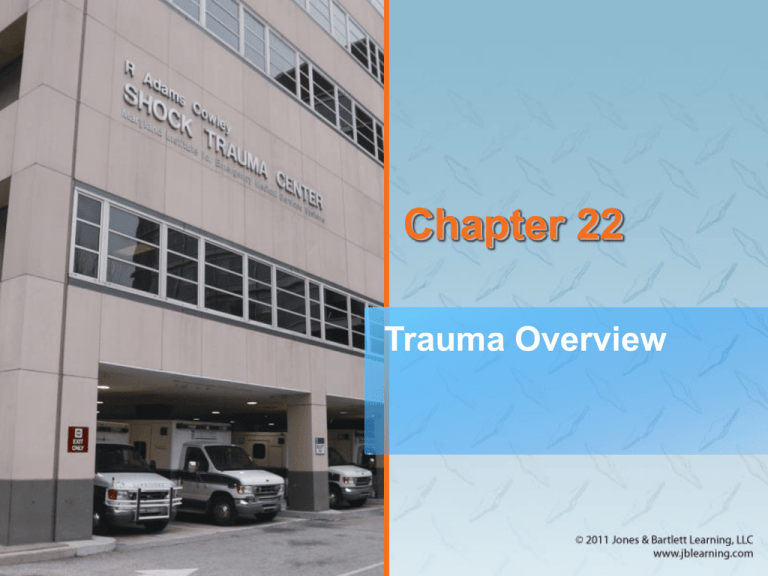
Chapter 22 Trauma Overview National EMS Education Standard Competencies (1 of 3) Trauma Applies fundamental knowledge to provide basic emergency care and transportation based on assessment findings for an acutely injured patient. National EMS Education Standard Competencies (2 of 3) Trauma Overview • Pathophysiology, assessment, and management of the trauma patient – Trauma scoring – Rapid transport and destination issues – Transport mode National EMS Education Standard Competencies (3 of 3) Multisystem Trauma • Recognition and management of: – Multisystem trauma • Pathophysiology, assessment, and management of: – Multisystem trauma – Blast injuries Introduction (1 of 2) • For people younger than age 40, traumatic injuries are the leading cause of death in the United States. – Traumatic emergencies occur as result of physical forces applied to the body. – Medical emergencies occur from an illness or condition not caused by an outside force. Introduction (2 of 2) • The index of suspicion is your awareness and concern for potentially serious underlying and unseen injuries. Energy and Trauma (1 of 4) • Traumatic injury occurs when the body’s tissues are exposed to energy levels beyond their tolerance. • The mechanism of injury (MOI) is the way traumatic injuries occur. – Describes the forces acting on the body that cause injury Energy and Trauma (2 of 4) • Three concepts of energy – Potential energy – Kinetic energy – Work • Energy can be neither created nor destroyed, but can only be converted or transformed. Energy and Trauma (3 of 4) • Work is force acting over a distance. • Work of a moving object is called kinetic energy. Courtesy of Mark Woolcock – Reflects the relationship between mass and velocity Energy and Trauma (4 of 4) • Potential energy is the product of mass, force of gravity, and height. – Mostly associated with the energy of falling objects Mechanism of Injury Profiles (1 of 2) • Different MOIs produce many types of injuries. • Nonsignificant injuries – Injury to an isolated body part – A fall without the loss of consciousness Mechanism of Injury Profiles (2 of 2) • Significant injuries: – Injury to more than one body system (multisystem trauma) – Falls from heights – Motor vehicle and motorcycle crashes – Car versus pedestrian – Gunshot wounds – Stabbings Blunt and Penetrating Trauma • Either type may occur from a variety of MOIs. • Blunt trauma is the result of force to the body that causes injury without penetrating the soft tissues. • Penetrating trauma causes injury by objects that primarily pierce and penetrate the surface of the body. Blunt Trauma • Results from an object making contact with the body • Motor vehicle crashes and falls are the most common MOIs. • Be alert to skin discoloration and pain. • Maintain a high index of suspicion for hidden injuries. Vehicular Collisions (1 of 6) • Motor vehicle crashes are classified as: – Frontal – Rear-end – Lateral – Rollovers – Rotational • The principal difference is the direction of the force of impact. Vehicular Collisions (2 of 6) • Car against another car, tree, or object – Damage to the car has an indirect effect on patient care. Source: © Jack Dagley Photography/ShutterStock, Inc. – By assessing the vehicle, you can often determine the MOI. Vehicular Collisions (3 of 6) • Passenger against the interior of the car Source: © Jack Dagley Photography/ShutterStock, Inc. – Common passenger injuries include lower extremity fractures, flail chest, and head trauma. Vehicular Collisions (4 of 6) Vehicular Collisions (5 of 6) • Passenger’s internal organs against solid structures of the body – Internal injuries may not be as obvious as external injuries, but are often the most life threatening. Vehicular Collisions (6 of 6) • Significant MOIs include the following findings: – Death of an occupant in the vehicle – Severe deformity of vehicle or intrusion into vehicle – Altered mental status – Ejection from the vehicle Frontal Collisions (1 of 5) • Evaluate supplemental restraint system – Seatbelts and air bags are effective in preventing a second collision inside the motor vehicle. – Air bags decrease the severity of deceleration injuries. – Air bags decrease injury to the chest, face, and head. Frontal Collisions (2 of 5) • Despite air bags, suspect injuries to: – Extremities (resulting from the second collision) – Internal organs (resulting from the third collision) Frontal Collisions (3 of 5) • Children shorter than 4' 9" should ride in the rear seat. – In a pickup truck or single-seated vehicle, the air bag should be turned off. • Remember that if the air bag did not inflate during the accident, it may deploy during extrication. Frontal Collisions (4 of 5) • Remember that supplemental restraint systems can cause harm whether they are used properly or improperly. Frontal Collisions (5 of 5) Rear-End Collisions (1 of 2) • Known to cause whiplash-type injuries – Particularly in absence of a headrest Source: © Crystalcraig/Dreamstime.com Rear-End Collisions (2 of 2) • As the body is propelled forward, the head and neck are left behind. • Acceleration-type injury to the brain is possible. – Third collision of the brain within the skull Lateral Collisions (1 of 3) • Side impacts • Commonly called T-bone collisions Source: © Dan Myers Lateral Collisions (2 of 3) • A vehicle struck from the side is usually struck above its center of gravity. – Begins to rock away from the side of impact – Results in the passenger sustaining a lateral whiplash injury Lateral Collisions (3 of 3) • If substantial intrusion into the passenger compartment, suspect: – Lateral chest and abdomen injuries on the side of the impact – Possible fractures of the lower extremities, pelvis, and ribs – Organ damage from the third collision Rollover Crashes • Large trucks and sport utility vehicles are prone. • Injuries depend on whether the passenger was restrained. • Most common life-threatening event is ejection or partial ejection of the passenger from the vehicle. Rotational Collisions • Spins are conceptually similar to rollovers. • Opportunities for the vehicle to strike objects – Such as utility poles Car Versus Pedestrian (1 of 2) • Injuries are often graphic and apparent. • Can also be serious unseen injuries • You should determine: – Speed of the vehicle – Whether the patient was thrown through the air – Whether the patient was struck and pulled under the vehicle Car Versus Pedestrian (2 of 2) • Evaluate the vehicle that struck the patient for structural damage. • ALS backup should be summoned for any patients who have sustained a significant MOI. Car Versus Bicycle (1 of 2) • Evaluate like you would for a carversus-pedestrian collision. – Also evaluate the damage to and position of the bicycle. Source: © Robert Byron/Dreamstime.com – If the patient was wearing a helmet, inspect it for damage. Car Versus Bicycle (2 of 2) • Presume that the patient has sustained an injury to the spinal column, or spinal cord, until proven otherwise at the hospital. • Spinal stabilization must be initiated and maintained during the encounter. Car Versus Motorcycle (1 of 4) • Protection using: – Helmet – Leather or abrasion-resistant clothing – Boots • Collisions usually occur against larger vehicles or stationary objects. Car Versus Motorcycle (2 of 4) • When you are assessing the scene, attention should be given to the: – Deformity of the motorcycle – Side of most damage – Distance of skid in the road – Extent and location of deformity in the helmet Car Versus Motorcycle (3 of 4) • Head-on collision – Motorcycle strikes another object and stops its forward motion while the rider continues • Angular collision – Motorcycle strikes an object at an angle so that the rider sustains direct crushing injuries to the lower extremity Car Versus Motorcycle (4 of 4) • Ejection – Rider will travel at high speed until stopped by a stationary object, another vehicle, or road drag. • Controlled crash – Technique used to separate the rider from the body of the motorcycle Falls (1 of 3) • Injury potential depends on the height from which the patient fell. – More than 15' or 3 times the patient’s height is considered significant. • Internal injuries pose the greatest threat to life. Falls (2 of 3) • Patients who fall and land on their feet may have less severe internal injuries. – Their legs may have absorbed much of the energy of the fall. Falls (3 of 3) • Take the following factors into account: – The height of the fall – The type of surface struck – The part of the body that hit first, followed by the path of energy displacement Penetrating Trauma (1 of 7) • Second leading cause of trauma death after blunt trauma – May be caused accidentally by impalement – May be caused intentionally by a knife, ice pick, or other weapon Penetrating Trauma (2 of 7) • With low-energy penetrations, injuries are caused by the sharp edges of the object moving through the body. • Knives may have been deliberately moved around internally, causing more damage than the external wounds suggest. Penetrating Trauma (3 of 7) • Path of the projectile may not be easy to predict. – Bullet may ricochet within the body before exiting. – Path the projectile takes is its trajectory. – Fragmentation will increase damage. Penetrating Trauma (4 of 7) • Cavitation can result in serious injury to internal organs. – Temporary cavitation is caused by the acceleration of the bullet. – Permanent cavitation is caused by the bullet path. Penetrating Trauma (5 of 7) • Relationship between distance and severity of injury varies depending on the type of weapon involved. – Drag slows the projectile. – Energy available for a bullet to cause damage is more a function of its speed than its mass. Penetrating Trauma (6 of 7) Medium velocity High velocity Penetrating Trauma (7 of 7) Blast Injuries (1 of 7) • Most common in war • Also seen in: – Mines – Shipyards – Chemical plants – Terrorist attacks Blast Injuries (2 of 7) Blast Injuries (3 of 7) • Primary blast injuries – Due entirely to the blast itself • Secondary blast injuries – Damage to the body results from being struck by flying debris. • Tertiary blast injuries – Victim is hurled by the force of the explosion. Blast Injuries (4 of 7) • Miscellaneous blast injuries – Burns from hot gases or fires started by the blast – Respiratory injury from inhaling toxic gases – Crush injury from the collapse of buildings • Most patients will have some combination of the four types of injury. Blast Injuries (5 of 7) • Organs that contain air are most susceptible to pressure changes. – Middle ear – Lung – Gastrointestinal tract • The ear is most sensitive to blast injuries. Blast Injuries (6 of 7) • Pulmonary blast injuries result from shortrange exposure to the detonation of explosives. • Arterial air embolisms can produce: – Disturbances in vision – Changes in behavior and state of consciousness – Variety of other neurologic signs Blast Injuries (7 of 7) • Solid organs are relatively protected from shock wave injury. – May be injured by secondary missiles or a hurled body • Neurologic injuries and head trauma are the most common causes of death. • Traumatic amputations are common. Multisystem Trauma • Involves more than one body system – Head and spinal trauma – Chest and abdominal trauma – Chest and multiple extremity trauma • Alert medical control and transport rapidly. Golden Principles of Prehospital Trauma Care (1 of 3) • Your main priority is to ensure: – Your safety – Safety of your crew – Safety of the patient • Determine the need for additional personnel or equipment. • Evaluate the kinematics of the MOI. Golden Principles of Prehospital Trauma Care (2 of 3) • Identify and manage life threats. • Then focus on patient care. – ABCs – Shock therapy – Backboard • Transport immediately to the appropriate facility. Golden Principles of Prehospital Trauma Care (3 of 3) • Definitive care requires surgical intervention. – On-scene time should be limited to 10 minutes or less. • Obtain a SAMPLE history and complete a secondary assessment. • Consider ALS intercept and/or medical transportation. Patient Assessment • Patient assessment consists of: – Scene size-up – Primary assessment – History taking – Secondary assessment – Reassessment • Perform a rapid full-body scan or rapid head-to-toe examination. Injuries to the Head • Disability and unseen injury to the brain may occur. • Bleeding or swelling inside the skull is often life threatening. • Include frequent neurologic examinations in your assessment. • Some patients will not have obvious signs or symptoms. Injuries to the Neck and Throat (1 of 2) • Area of serious or deadly injuries. • Airway problems may result. • Look for DCAP-BTLS in the neck region. • Swelling may prevent blood flow to the brain. Injuries to the Neck and Throat (2 of 2) • Penetrating injury may result in air embolism. • Crushing injury may cause the cartilages of the upper airway and larynx to fracture. Injuries to the Chest (1 of 2) • Chest contains heart, lungs, and large blood vessels. • Many life-threatening injuries may occur to the chest. – Broken ribs may hinder breathing. – Heart may be bruised. – Large vessels may be torn. Injuries to the Chest (2 of 2) • A penetration or perforation of the integrity of the chest is called an open chest wound. – Assess the chest region every 5 minutes. – Assessment should include DCAP-BTLS, lung sounds, and chest rise and fall. Injuries to the Abdomen (1 of 2) • Abdomen contains vital organs that require a very high amount of blood flow • Solid organs include the liver, spleen, pancreas, and kidneys. • Hollow organs include the stomach, large and small intestines, and urinary bladder. Injuries to the Abdomen (2 of 2) • Solid organs may tear, lacerate, or fracture. • Hollow organs may rupture and leak acidlike digestive chemicals. • The rupture of large blood vessels can cause serious unseen bleeding. Management: Transport and Destination (1 of 8) • Scene time – Survival of critically injured trauma patients is time dependent. – Critically injured patient: • Dangerous MOI • Decreased level of consciousness • Threats to airway, breathing, or circulation Management: Transport and Destination (2 of 8) • Type of transport – Ground EMS units are staffed by EMTs and paramedics. – Air EMS units or critical care transport units are staffed by critical care nurses and paramedics. Management: Transport and Destination (3 of 8) • Destination selection – Level I facility • Serves large cities or heavily populated areas • Provides every aspect of trauma care • Usually university-based hospitals – Level II facility • Located in less population-dense areas • Provides initial definitive care Management: Transport and Destination (4 of 8) • Destination selection (cont’d) – Level III facility • Provides assessment, resuscitation, emergency care, and stabilization • Transfers patients to Level I or Level II facility when necessary – Level IV facility • Found in remote outlying areas • Provides advanced trauma life support Management: Transport and Destination (5 of 8) Management: Transport and Destination (6 of 8) • The American College of Surgeons’ Committee on Trauma provides criteria for Level I and II trauma patient classifications. Management: Transport and Destination (7 of 8) Management: Transport and Destination (8 of 8) • Special considerations – Remain calm. – Complete an organized assessment. – Correct life-threatening injuries. – Do no harm. – Never hesitate to contact ALS backup or medical control for guidance. Summary (1 of 7) • Determine the mechanism of injury (MOI) as quickly as possible. • Three concepts of energy are typically associated with injury: potential energy, kinetic energy, and work. • Traumatic injuries can be described as blunt trauma or penetrating trauma. Summary (2 of 7) • Motor vehicle crashes are classified traditionally as frontal (head-on), lateral (T-bone), rear-end, rotational (spins), and rollovers. Summary (3 of 7) • In every crash three collisions occur: – Collision of the vehicle against some type of object – Collision of the passenger against the interior of the vehicle – Collision of the passenger’s internal organs against the solid structures of the body Summary (4 of 7) • Maintain a high index of suspicion for serious injury in the patient who has: – Been involved in a motor vehicle collision – Been involved in a motor vehicle collision with significant damage to the vehicle – Fallen from a significant height – Sustained penetrating trauma to the body Summary (5 of 7) • People who are injured in explosions may have injuries that are classified as primary blast injuries, secondary blast injuries, tertiary blast injuries, and/or miscellaneous blast injuries. Summary (6 of 7) • A patient who has sustained a significant MOI and is considered to be in serious or critical condition should receive a full-body examination. • A patient who has sustained a nonsignificant MOI should receive an assessment focused on the chief complaint. Summary (7 of 7) • Caring for victims of traumatic injuries requires the EMT to have a solid understanding of the trauma system in the United States.
